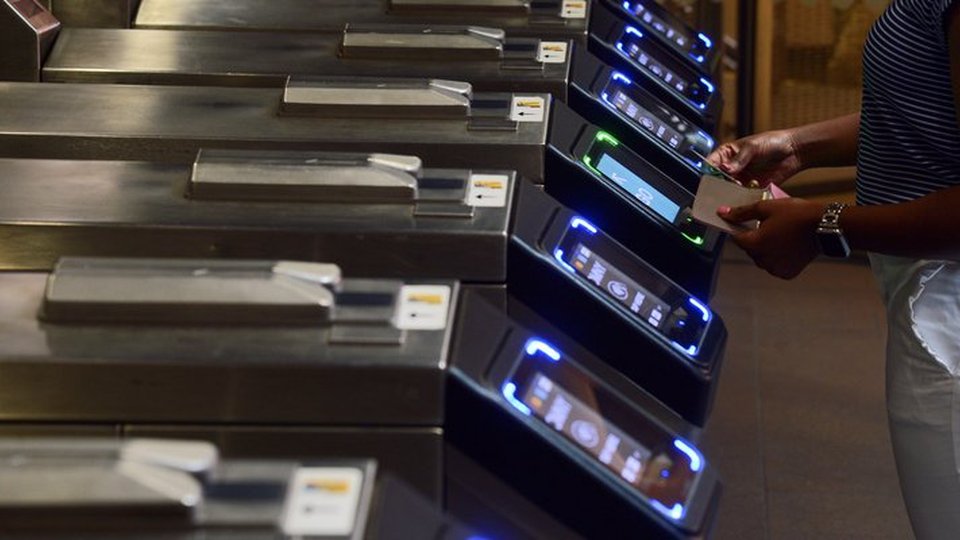Transportation
Coronavirus pushes transit systems to adopt contactless
Public transit systems are speeding up their efforts to promote contactless travel as the COVID-19 pandemic has devastated ridership and revenue on many of these systems.

July 22, 2020 by David Jones — Editor, Networld Media Group
Editor's note: An earlier version of this article ran on Mobile Payments Today, a Kiosk Marketplace sister publication.
As the country begins to reopen business from an extended COVID-19 lockdown, public transit systems are scrambling to implement contactless fare technologies to accommodate millions of commuters, retail shoppers and others that avoided subways and buses at historic levels to reduce community spread.
With confirmed infections rising in many parts of the country, transit specialists and payments companies are urgently working to implement contactless systems that can allow bus and subway operators to process and collect fares that have historically relied on cash paying customers. Since the lockdown began in March, many of these systems have seen ridership revenue collection plummet to historic lows, so the resumption of service will now require fare collection methods that minimize contact, while making travel and fare collection safer and more efficient.
"For the protection of riders and transit employees in the COVID era, agencies are seeking to minimize contact between these parties," Randy Vanderhood, director of the U.S. Payments Forum, told this website. "Mobile ticketing and contactless fare cards are a great way to achieve this, while providing a faster, safer and more convenient means for fare collection."
Companies in the payments space are working diligently with transit agencies to recover from the lockdown, as commuters are a key driver of mobile commerce across the globe.
Demand rises for contactless
"We're seeing a greater sense of urgency to adopt these touchless solutions as part of an overall strategy to help limit interaction with surfaces, sales counters, ticket machines and cash handling," Ana Reiley, global head of delivery, urban mobility at Visa, told this website via email. "And consumer data shows that contactless is the preferred way to pay."
She cited data showing that after reaching a low at the global peak of the pandemic in April, contactless transactions recovered more than 187% by June. Visa said it it is working on more than 500 urban mobility projects worldwide and has 150 Visa Ready for Technology partners to help deploy contactless systems in cities across the globe, including Brussels, Bratislava, Bucharest, Hong Kong, Santo Domingo and Turin, Italy.
"Demand for rapid contactless implementations of proven solutions is higher now than anytime before," according to Eric Reese, CEO of Bytemark, a New York-based unit of Siemens Co., that provides fare collection and trip planning tools for public transit agencies.
He told Mobile Payments Today that that transit agencies are looking to transition from cash-based fare collection to contactless systems that allow for safe social distancing in order to protect customers and workers.
Public transit systems are particularly vulnerable to COVID-19 because about 22 million households in the U.S. are either unbanked or underbanked and 40% of public transit users make below $40,000 a year and 60% of transit users are people of color, according to Rahul Kumar, executive vice president, market development and innovation at Keolis North America, part of a Paris-based multinational that specializes in transportation mobility.
Reduced ridership
In cities like New York City, which was previously the epicenter of the global COVID-19 pandemic, daily subway ridership by mid-April fell to 366,000, a decrease of 93% from year-ago levels. Ridership has begun to recover, but is still down about 77% from a year ago at 1.2 million as of July 15, according to data released by the Metropolitan Transportation Authority.
The agency earlier this month expanded the rollout of its OMNY contactless fare payment system to the Bronx, bringing systemwide deployment to about 60% The OMNY system allows riders to tap and go using contactless cards and mobile wallets, including Apple Pay, Google Pay, Samsung Pay and the wearable Fitbit Pay.
Officials at Cubic Corp., a San Diego-based firm that has worked on some of the nation's largest contactless transit projects, including OMNY, said transit systems have been slow to recover in key international markets due to ongoing concerns about safety and the need to implement more advanced fare collection methods that allow for safe social distancing.
"In the U.S., U.K. and Australia, we are seeing a slow return to public transit," Mick Spiers,vice president and general manager of platforms at Cubic Transportation Systems, told Mobile Payments Today via email. "People are returning to driving and active mobility modes (like walking and cycling) faster than they are returning to public transit at this early stage. This is a worrying trend as it will lead to increased traffic on roads that were already congested pre-COVID."
Spiers said the company is working with technology that automatically monitors sanitation levels in transit stations and uses AI-based technology to determine whether commuters are wearing face masks and if not, issues reminders. The company ultimately wants to have riders in a touch-free environment, which includes using technology including the Cubic Virtual Ticket Agency, which uses AI-based avatars to provide multilingual customer service while limiting customer interaction with staff. The technology also uses contactless EMV credit and debit cards and increased adoption of mobile wallets like Apple Pay, Google Pay and Samsung Pay.
Last month, Cubic entered a partnership with InComm to provide a nationwide network of stored value cards that will allow cash paying customers to convert their funds using Cubic's TouchPass electronic fare collection system. Cubic also reached an agreement with the Massachusetts Bay Transportation Authority to roll out a phased expansion of a contactless fare payment system that will allow customers to use mobile payments and contactless cards by 2024.
Earlier this week, Uber, along with partners Masabi and NEOride, launched the rollout of Uber Transit Ticketing across multiple public transit systems in the states of Ohio and Kentucky, where commuters will be able to purchase tickets and ride across 13 different transit agencies in northern Kentucky and the Cincinnati areas using an Uber mobile app.
"This new service makes it easier and more convenient for Uber users to plan a journey and travel using multiple modes of transportation (public and private) across multiple transit agencies, all from within the same application, quickly and safely," said James Gooch, head of marketing at Masabi.
About David Jones
David Jones is the editor of Mobile Payments Today. He is a veteran business and technology journalist, with three decades of experience writing about business travel, real estate and technology.
Since 2015 he covered a range of technology stories for the ECT News Network, which includes the E-Commerce Times, TechNewsWorld, LinuxInsider and CRM Buyer, writing about cybersecurity, artificial intelligence, machine learning, open source computing and privacy issues among others. He recently covered FinTech issues for PYMNTS.com.
He worked as a staff writer for Bloomberg Business News and an online reporter for Crain’s New York Business. He has written for numerous media organizations, including Reuters, The New York Times, The Real Deal, Continental, City Limits and The Nation.
He was previously awarded the George Washington Williams Fellowship for Journalists of Color by the Independent Press Association.










